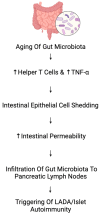Pathology of Diabetes-Induced Immune Dysfunction
- PMID: 39000211
- PMCID: PMC11241249
- DOI: 10.3390/ijms25137105
Pathology of Diabetes-Induced Immune Dysfunction
Abstract
Diabetes is associated with numerous comorbidities, one of which is increased vulnerability to infections. This review will focus on how diabetes mellitus (DM) affects the immune system and its various components, leading to the impaired proliferation of immune cells and the induction of senescence. We will explore how the pathology of diabetes-induced immune dysfunction may have similarities to the pathways of "inflammaging", a persistent low-grade inflammation common in the elderly. Inflammaging may increase the likelihood of conditions such as rheumatoid arthritis (RA) and periodontitis at a younger age. Diabetes affects bone marrow composition and cellular senescence, and in combination with advanced age also affects lymphopoiesis by increasing myeloid differentiation and reducing lymphoid differentiation. Consequently, this leads to a reduced immune system response in both the innate and adaptive phases, resulting in higher infection rates, reduced vaccine response, and increased immune cells' senescence in diabetics. We will also explore how some diabetes drugs induce immune senescence despite their benefits on glycemic control.
Keywords: diabetes; immune dysfunction; immune senescence; infection; latent autoimmune diabetes in adults; medication side effects; vaccine uptake.
Conflict of interest statement
The authors declare no conflicts of interest.
Figures




References
-
- Greenway F., Loveridge B., Grimes R.M., Tucker T.R., Alexander M., Hepford S.A., Fontenot J., Nobles-James C., Wilson C., Starr A.M., et al. Physiologic insulin resensitization as a treatment modality for insulin resistance pathophysiology. Int. J. Mol. Sci. 2022;23:1884. doi: 10.3390/ijms23031884. - DOI - PMC - PubMed
-
- Yang J.K., Feng Y., Yuan M.Y., Yuan S.Y., Fu H.J., Wu B.Y., Sun G.Z., Yang G.R., Zhang X.L., Wang L., et al. Plasma glucose levels and diabetes are independent predictors for mortality and morbidity in patients with sars. Diabet. Med. J. Br. Diabet. Assoc. 2006;23:623–628. doi: 10.1111/j.1464-5491.2006.01861.x. - DOI - PubMed
-
- Hulme K.D., Tong Z.W.M., Rowntree L.C., van de Sandt C.E., Ronacher K., Grant E.J., Dorey E.S., Gallo L.A., Gras S., Kedzierska K., et al. Increasing hba1c is associated with reduced cd8(+) t cell functionality in response to influenza virus in a tcr-dependent manner in individuals with diabetes mellitus. Cell Mol. Life Sci. 2024;81:35. doi: 10.1007/s00018-023-05010-4. - DOI - PMC - PubMed
Publication types
MeSH terms
LinkOut - more resources
Full Text Sources
Medical

